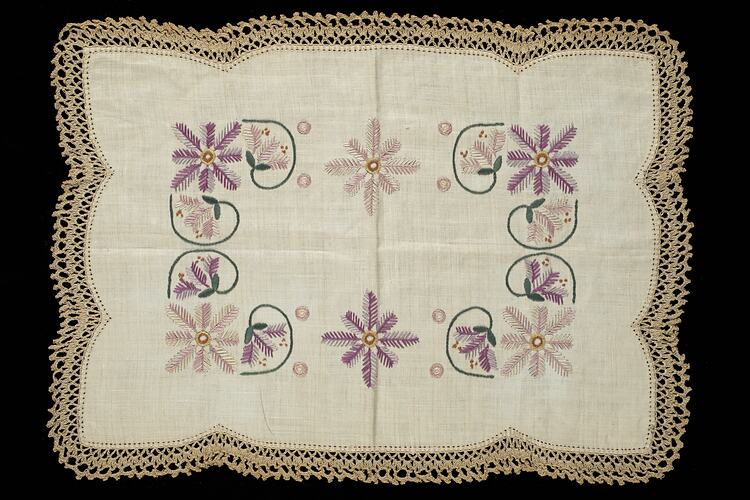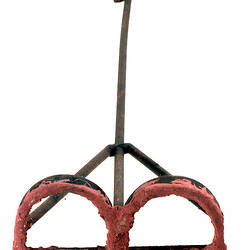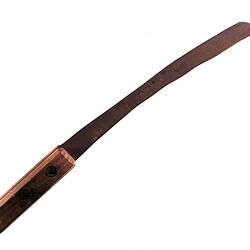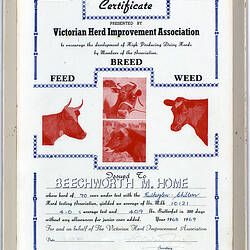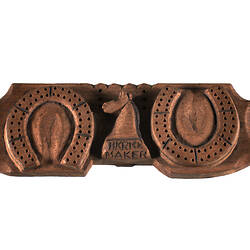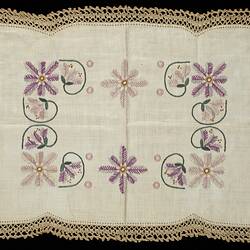Summary
An account of patient occupational and art therapy in psychiatric hospitals in Victoria, Australia from 1879 to 1959.
When Henry Clarke was appointed gardener to the Ararat Lunatic Asylum in 1879 the grounds were in such disrepair that he needed patient labour to turn things around. Contrary to his expectations the patients were remarkably cooperative and dependable. Drawing on what he had learned about patient management, he suggested that:
During the coming summer let a party of selected volunteer patients of the really insane be placed on a selection of land, say in Gippsland, where there is good land, water, and timber. Let them be supplied with tents, tools, and rations only . . . Let them make their own rules, the manager interfering as little as possible, except to set out the work and that order is kept (Report of the Royal Commission on Asylums for the Insane and Inebriate 1886, Minutes of Evidence, Q.5541, p. 224).
Clarke firmly believed that patients 'brought into contact with nature' and 'given as much freedom as possible' did better and contributed more to the asylum than those leading more restricted lives.
Many international asylum administrators agreed that patients did improve if encouraged to take part in a range of practical activities which provided 'useful labour' on asylum farms and orchards, on general maintenance of mental hospital buildings, and in the institution's laundry, sewing, carpentry and boot-making rooms (Porter, 1997, p. 496). Dr John O'Brien, Medical Superintendent of Kew Asylum in the 1880s, went so far as to remark that occupational treatment was the only curative measure of any value in restoring patients to sanity (Brothers, 1962, p. 170).
The term 'working patients', widely used throughout Victoria's asylum system in the late nineteenth century, were rewarded for their work, with extra food, beer, porter and tobacco, or increased freedom of movement (Report of the Royal Commission on Asylums for the Insane and Inebriate 1886, General Index to Evidence, p. clxxi and Minutes of Evidence, Q.2178-2189, p. 103; Q.3841-3860, p. 160; Q. 4449-4456, p. 179; Q.9397, p. 395). Patients were encouraged but not forced to work, and well into the twentieth century, asylums relied on working patients to do jobs for small reward to stay within budget.
Working opportunities for patients expanded in 1918 when the head of Victoria's mental health services, Dr W. Ernest Jones, introduced occupational training workshops for returned servicemen and women in mental health institutions. Carpenters, tailors, shoemakers, tinkers, saddlers, poultry farmers and inlay cabinet workers were trained and assisted in finding employment. Jones also initiated basket-making and sea-grass furniture shops at the Janefield Colony for Mentally Deficient Children, situated where La Trobe University was later located. He also introduced expert instruction in gardening and landscaping at the nearby Bundoora Repatriation Mental Hospital. Describing these moves as among the Lunacy Department's first attempts at vocational training, he said they proved to be of excellent curative value for those returnees who were "nervy" or shocked (Jones, unpublished memoirs).
In the early 1930s, formal classes started in Victorian mental health hospitals based on the concept that occupying the hands and minds of patients in productive ways could prove to be therapeutic. The introduction of classes followed an intervention by the Mental Hospitals' Auxiliaries organisation, a volunteer group concerned about the welfare of mental hospital patients. In 1934 it funded the salary of Sister Lucy Symes for six months to run classes at Mont Park and Kew Mental Hospitals (Cameron, 1977, p. 13). The experiment proved successful, and the Mental Hygiene Department appointed Symes to its staff. She continued in the position of departmental occupational therapist until 1949, by which time she was training other staff members to take charge of occupational therapy (OT) centres in various mental health hospitals (Annual Report of the Central Council of the Mental Hospitals' Auxiliaries of Victoria, 1957, p. 2). Examples of patients craft work were displayed at the Victoria Coffee Palace or the Melbourne Town Hall (Argus, 1940, p. 6).
Recognition by authorities of the value of OT is evident in a comment by the Medical Superintendent of the Ararat Mental Hospital, Dr Horace Edmonds. Criminally insane patients in 'J Ward' were 'confined in a small area with little opportunity of occupying their minds' and he 'hoped that some occupational therapy will be made possible in the near future' (Report of the Director of Mental Hygiene 1946, p. 15). Within a decade, an OT Unit had been established in 'J Ward' while others were established at Kew, Bundoora, Larundel and Janefield.
During the 1950s and 1960s, a dual emphasis developed on encouraging patients to express themselves through creative arts such as drawing, painting and writing (for example, in hospital magazines) as well as giving patients experience of industrial-type work. The development of these two streams was driven by Dr Eric Cunningham Dax, Chairman of the Mental Hygiene Authority (later the Mental Health Authority) from 1952 to 1969.
Art therapy and written works
By the time Dax started work in Victoria in the early 1950s, he was convinced that patients' artistic works could have diagnostic value, helping psychiatrists to better understand the nature and cause of a patient's mental illness. These convictions derived from his past experience at Netherne Hospital in England where patients were encouraged to express themselves through painting, drawing and needlework.
Dax encouraged patients in Victoria's mental health institutions to develop their artistic talents and he employed experienced artists to help teach them. He used patients' artistic works to assist with teaching the symptoms of various psychiatric conditions to medical, nursing and paramedical students and staff, and emphasised their use in providing a record of change in patients' mental health over time.
He further suggested that the creative works of patients could help increase community awareness of the experience of mental illness (Dax, 1953, passim). To this end, he collected and displayed such works, culminating in the development of the Eric Cunningham Dax Psychiatric Art Collection located at Royal Park Mental Hospital and later at the Parkville campus of the University of Melbourne. He oversaw the classification of the collection according to diagnosis of mental health conditions - an approach that proved controversial (Robson, 1999, p. 345).
Another creative form of activity to emerge in the 1950s was the production of patient magazines. Patients at Mont Park Mental Hospital produced The Window, while those at Sunbury produced Awareness magazine. At Beechworth, the patient magazine was titled Open Door, at Traralgon Psychiatric Hospital it was Insight and at Sandhurst Boy's Centre in Bendigo it was Guiding Light.
Patients generally wrote, edited and illustrated most of the magazines, with those having a background in publishing or entertainment particularly sought after for these jobs. Simple in format, magazines were made available to former patients and friends of institutions for a small payment. They were produced for nearly two decades at many hospitals, and were welcomed by administrators and patients alike for encouraging patient initiative and enhancing patient-staff interaction.
Industrial-type work
In 1957, Dax encouraged the Victorian Employers' Federation to establish a similar not-for-profit employment organisation as he had seen operating successfully in Holland. VATMI (Victoria's Aid to the Mentally Ill) liaised between industry and mental health hospitals to provide paid labour for patients. It's role included finding industrial contracts from firms, transporting raw materials and finished goods, and saw to the satisfactory and speedy conclusion of projects by selected patients as paid occupational therapy (Annual Report of the Advisory Committee to the Mental Hygiene Authority for 1959, p. 3). Half the proceeds went in staff salaries and the rest to the Mental Hygiene Trust Fund. Patients benefitted from gaining experience of industrial work that might help them get employment after leaving an institution, while companies benefitted by contributing to patient welfare and avoiding having to pay all proceeds of the sale of goods into revenue.
VATMI survived for many decades, though it was seen to be competing for labour against the other forms of occupational therapy and work given to patients in mental hospitals, and the payment to patients was sometimes considered inadequate after taking account of costs they were charged, such as for transport to and from workplaces. The consensus was that 'It is most encouraging to see patients of long standing progressing in their recovery due . . . to occupational therapy designed to lead on to industrial activities' (Annual Report of the Advisory Committee to the Mental Hygiene Authority for 1959, p. 2).
References
Annual Report of the Advisory Committee to the Mental Hygiene Authority (1959), La Trobe Australian Manuscripts Collection, State Library of Victoria, Mental Health Auxiliaries Collection, Box 5
Annual Report of the Central Council, Mental Hospitals' Auxiliaries of Victoria (1957), La Trobe Australian Manuscripts Collection, State Library of Victoria, Mental Health Auxiliaries Collection, Box 4
Argus (1940), 'Handwork Helps Patients Recover', 29 October, p. 6
Brothers, C R D (1962), Early Victorian Psychiatry 1835-1905, Melbourne, author-published
Cameron, B S (1977), The work of our hands: a history of the Occupational Therapy School of Victoria, Hawthorn, author-published,
Dax, E C (1953), Experimental Studies in Psychiatric Art, London, Faber and Faber
Jones, W E, unpublished memoirs, Victorian Mental Health Collection, Royal Melbourne Hospital
Porter, Roy (1997), The Greatest Benefit to Mankind. A Medical History of Humanity from Antiquity to the Present, London, Harper Collins
Report of the Director of Mental Hygiene 1946 (1947-48), Victorian Parliamentary Papers, vol. 2
Report of the Royal Commission on Asylums for the Insane and Inebriate, Victoria (1886), Victorian Parliamentary Papers, vol. 2
Robson, Belinda (1999), 'A History of the Cunningham Dax Collection of 'Psychiatric Art': From Art Therapy to Public Education', Health and History, vol. 1, no. 4, December, pp. 330-346
More Information
-
Keywords
-
Authors
-
Article types
